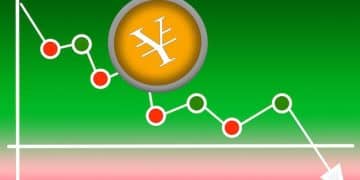Investing in Series I Bonds: Your Safe Haven Against Inflation

Investing in Series I Bonds offers a secure way to protect your savings from inflation, providing a guaranteed return tied to the Consumer Price Index, making them an attractive option for preserving purchasing power.
Looking for a safe and reliable way to shield your savings from the relentless impact of inflation? Investing in Series I Bonds could be the answer, offering a unique combination of security and inflation protection.
Understanding Series I Bonds
Series I Bonds are a type of U.S. Treasury security specifically designed to protect your savings from inflation. They offer a fixed interest rate combined with an inflation-adjusted rate, ensuring your investment keeps pace with rising prices. This makes them a popular choice for risk-averse investors seeking a safe haven for their funds.
How Series I Bonds Work
Investing in Series I bonds is straightforward. They are purchased directly from the U.S. Department of the Treasury through TreasuryDirect.gov. The interest earned on I bonds is exempt from state and local taxes, and federal income tax can be deferred until the bond is redeemed or matures (after 30 years).
Key Features of Series I Bonds
Series I Bonds have some specific characteristics that make them unique to other bonds.
- Fixed Rate: The bonds come with a fixed rate that stays constant for the life of the bond
- Inflation Rate: An inflation rate is determined, and it changes twice a year (May and November)
- Composite Rate: The combination of the two rates determines the interest you will earn
Series I Bonds help you grow your wealth, not just keep it. As they are tied to inflation, they adjust with the economy.

The Guaranteed 6.89% Return: Demystified
One of the most attractive features of Series I Bonds in recent times has been the high annualized interest rate. This rate is a combination of a fixed rate, which remains constant for the life of the bond, and an inflation rate, which is adjusted twice a year based on changes in the Consumer Price Index (CPI). This ensures that the return on your investment keeps pace with inflation, preserving your purchasing power.
Understanding the Rate Components
The composite rate is calculated using a formula that combines the fixed rate and the inflation rate. When inflation is high, this composite rate can be significantly higher than traditional savings accounts or certificates of deposit (CDs). Because of the way I bonds work, they are an especially helpful way to grow your net worth during periods of economic uncertainty.
How the Rate Changes
The inflation rate component of Series I Bonds is adjusted every six months, in May and November. This means the overall return on your bond can fluctuate over time, depending on changes in the CPI. However, the fixed rate remains constant, providing a base level of return regardless of inflation.
Having a guaranteed interest rate is helpful as it can take a lot of guesswork out of the process of building wealth.
Series I Bonds vs. Other Investments
When considering where to allocate your investment dollars, it’s essential to weigh the pros and cons of different options. Series I Bonds offer a unique set of benefits that make them an attractive alternative to traditional savings accounts, stocks, and real estate.
Series I Bonds vs. Savings Accounts
While savings accounts offer easy access to your funds and are generally low-risk, they typically offer low interest rates that may not keep pace with inflation. Investing in Series I Bonds, on the other hand, provides a guaranteed return that is tied to inflation, ensuring your savings maintain their purchasing power.
Series I Bonds vs. Stocks
Stocks can offer the potential for high returns, but they also come with significant risk. The stock market can be volatile, and there is no guarantee of a positive return. Series I Bonds, on the other hand, are virtually risk-free, backed by the full faith and credit of the U.S. government.
Series I Bonds vs. Real Estate
Real estate can be a good long-term investment, but it requires a significant upfront investment and comes with ongoing costs such as property taxes, insurance, and maintenance. Series I Bonds can be purchased in smaller increments, making them more accessible to a wider range of investors, and they require no ongoing maintenance.

Who Should Consider Series I Bonds?
Series I Bonds are not for everyone, but they can be a particularly attractive option for certain types of investors. These bonds provide you with diversity within your portfolio, without having to make many different decisions.
Risk-Averse Investors
If you are risk-averse and prioritize capital preservation over high returns, Series I Bonds may be a good fit for your investment portfolio. They offer a safe and secure way to grow your savings without exposing yourself to the volatility of the stock market.
Long-Term Savers
Series I Bonds are designed to be held for the long term, making them a good choice for individuals saving for retirement or other long-term goals. While you can redeem the bonds after one year, you will forfeit the last three months of interest if you redeem them before five years.
Inflation-Conscious Individuals
If you are concerned about the impact of inflation on your savings, Series I Bonds can provide a valuable hedge. By offering a return that is tied to the CPI, they help ensure that your savings maintain their purchasing power over time
When deciding if you want to include Series I Bonds in your portfolio, consider your goals and your unique personal situation.
How to Purchase and Manage Series I Bonds
Purchasing and managing Series I Bonds is a straightforward process that can be done online through the TreasuryDirect.gov website. The process is simple. To purchase these bonds, you must be a U.S. citizen, resident, or other entity who can receive payments.
Opening a TreasuryDirect Account
The first step is to open a TreasuryDirect account. You will need to provide your Social Security number, address, and bank account information.
Purchasing Series I Bonds
Once your account is set up, you can purchase Series I Bonds in electronic form. The minimum purchase amount is $25, and you can purchase up to $10,000 per year. You can also purchase an additional $5,000 in paper bonds using your federal income tax refund. Using the website is a great way to control your investment.
Managing Your Bonds
Through your TreasuryDirect account, you can track the value of your bonds, view your interest earnings, and redeem your bonds when you are ready. You can also designate beneficiaries to receive your bonds in the event of your death.
Purchasing Series I Bonds is a great way to take more control over some of your investments.
Tax Implications of Series I Bonds
Series I Bonds offer some attractive tax benefits that can make them an even more appealing investment option. While the interest earned on I bonds is subject to federal income tax, it is exempt from state and local taxes.
Federal Income Tax
You have the option of paying federal income tax on the interest earned each year, or you can defer the tax until you redeem the bonds or they mature. Deferring the tax can be advantageous if you expect to be in a lower tax bracket in the future.
Education Tax Exclusion
In some cases, you may be able to exclude the interest earned on Series I Bonds from your federal income tax if you use the proceeds to pay for qualified higher education expenses. This exclusion is subject to certain income limitations.
Do some research or confer with a professional about the best way to approach the tax implications of your investments.
| Key Point | Brief Description |
|---|---|
| 🛡️ Inflation Protection | Tied to CPI, ensures savings maintain purchasing power. |
| 🏦 Guaranteed Return | Offers a fixed rate combined with inflation-adjusted rate. |
| 💸 Tax Advantages | Exempt from state and local taxes; federal tax can be deferred. |
| 🔒 Low Risk | Backed by the full faith and credit of the U.S. government. |
Frequently Asked Questions
Series I Bonds are a type of U.S. Treasury bond designed to protect your savings from inflation. They earn interest based on a combination of a fixed rate and an inflation rate.
You can purchase Series I Bonds online through the TreasuryDirect website. You will need to create an account and provide your Social Security number and bank account information.
The interest rate on Series I Bonds is a composite rate that is adjusted twice a year, in May and November. The rate is based on a fixed rate and an inflation rate.
The interest earned on Series I Bonds is subject to federal income tax, but it is exempt from state and local taxes. You can defer paying federal income tax until you redeem them.
Yes, you can give Series I Bonds as a gift. You can purchase them in electronic form and transfer them to the recipient’s TreasuryDirect account.
Conclusion
Investing in Series I Bonds offers a compelling opportunity to protect your savings from inflation while earning a guaranteed return. With their unique combination of safety, tax advantages, and inflation protection, Series I Bonds can be a valuable addition to any investment portfolio. By understanding how these bonds work and their potential benefits, you can make an informed decision about whether they are the right investment for your financial goals.





